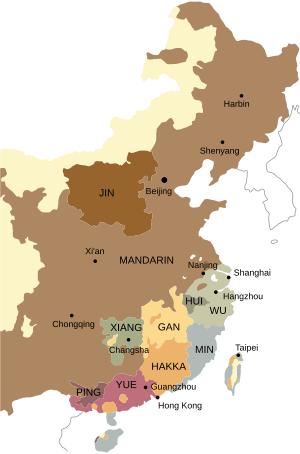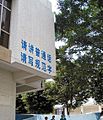Varieties of Chinese facts for kids
Quick facts for kids Chinese |
|
|---|---|
| Sinitic | |
| Ethnicity: | Han Chinese |
| Geographic distribution: |
Mainland China, Hong Kong, Macau, Taiwan, Southeast Asia and other regions with historic immigration from China |
| Linguistic classification: | Sino-Tibetan
|
| Subdivisions: |
Jin
Hui
Xiang
Min
Ping
|
| ISO 639-5: | zhx |
 Primary branches of Chinese according to the Language Atlas of China
|
|
Chinese is a group of languages that belong to the Han-Tibetan language family. There are hundreds of different local Chinese languages. Many of these languages are not mutually understandable. This means speakers of one Chinese language might not understand speakers of another.
You'll find more differences in the languages spoken in the mountainous areas of southeast China. The main seven groups are Mandarin, Wu, Min, Xiang, Gan, Hakka, and Yue. Scientists are still studying these languages.
Chinese languages differ most in their phonology (how they sound). But they often share similar vocabulary (words) and syntax (grammar rules). Southern Chinese languages tend to have fewer starting consonant sounds. However, they often keep the ending consonant sounds from Middle Chinese, an older form of the language.
All Chinese languages use tones. This means the meaning of a word can change depending on the pitch of your voice. Northern Chinese languages usually have fewer tones. Many also have tone sandhi, which is when the tone of a word changes because of the tones of words next to it. The coastal areas of Zhejiang and eastern Guangdong have some of the most complex tone patterns.
Standard Chinese is the official language of China. It is also one of the four official languages of Singapore. Plus, it's one of the six official languages used by the United Nations. This standard language is based on the Beijing dialect. Its words come mostly from the Mandarin group. Its grammar is based on modern written Chinese literature.
Contents
A Look at Chinese Language History
Around 2000 BC, a form of Chinese was spoken near the Huanghe River. Over time, it spread east across the North China Plain to Shandong. Then it moved south towards the Yangzi River valley. As it spread, it replaced other languages in the south.
Throughout history, when China was united, people wanted a common language. This made it easier for everyone to communicate.
How Chinese Languages Changed
We know that different ways of speaking Chinese existed a long time ago. Texts from the Spring and Autumn period (722–479 BC) show these differences. During this time, the Zhou still had a standard way of speaking.
Later, a book called the Fangyan (from the 1st century CE) studied how words differed in different regions. Texts from the Eastern Han period also talked about local differences in how words were pronounced.
The Qieyun rhyme book (601 CE) noticed many different pronunciations across regions. It aimed to create a standard pronunciation for reading old classic texts. This standard is now called Middle Chinese.
The North China Plain is flat and open. This made it easy for people to travel and communicate. Because of this, people in the north generally spoke very similar languages.
However, South China has many mountains and rivers. These natural barriers made it harder for people to connect. This is why South China developed six major groups of Chinese languages. There are many differences even within these groups, especially in Fujian.
Modern Standard Chinese
Until the mid-1900s, most Chinese people only spoke their local language. But the Ming and Qing dynasties created a common language. It was based on Mandarin and called Guānhuà (官話), meaning "speech of officials." If you wanted to work for the government, you had to know Guanhua.
Before the 20th century, Classical Chinese was the standard for writing. But the Republic of China later changed this. They made written vernacular Chinese the new standard. This new written style was based on northern dialects.
In the 1930s, a standard national language was chosen. Its pronunciation came from the Beijing dialect. But its vocabulary also included words from other Mandarin languages. Today, this is the official spoken language of the People's Republic of China.
Now, Standard Mandarin Chinese is used everywhere in public life. The only other Chinese language commonly taught in colleges is Cantonese.
The Different Chinese Language Groups
Proportions of first-language speakers Mandarin (65.7%)
- Mandarin:
- Spoken in northern and southwestern China.
- Has the most speakers of any Chinese language.
- Includes the Beijing dialect, which is the basis for Standard Chinese.
- Also includes the Dungan language spoken in Kyrgyzstan and Kazakhstan. This language is written using the Cyrillic script.
- Wu:
- Spoken in Shanghai, most of Zhejiang, and parts of Jiangsu and Anhui.
- Has hundreds of different spoken forms. Many of these are not mutually intelligible.
- Uses stops, affricates, and fricatives in its sounds.
- Xiang:
- Min:
- Spoken in Fujian and eastern Guangdong.
- Is older than Middle Chinese.
- Is the most diverse group of Chinese languages.
- Varieties from the coast of Fujian, especially around Xiamen, have spread to Southeast Asia (called Hokkien) and Taiwan (called Taiwanese Hokkien).
- Also spoken in Hainan, the Leizhou Peninsula, and other parts of southern China.
- Hakka:
- Yue (Cantonese):
- Spoken in Guangdong, Guangxi, Hong Kong, and Macau.
- Many speakers have moved to Southeast Asia and other parts of the world.
- The most well-known and widely spoken variety is Cantonese, from the city of Guangzhou (historically called "Canton").
- Cantonese is also the main language for most people in Hong Kong and Macau.
- Uses the same ending sounds as Hakka.
- Has many tones, making it sound very musical.
How the Groups Are Related
Chinese languages are sometimes put into three main groups:
- Northern: This includes Mandarin.
- Central: This includes Wu, Gan, and Xiang.
- Southern: This includes Hakka, Yue, and Min.
The Southern group might have come from the Yangzi River area during the Han dynasty (206 BC – 220 AD). This is sometimes called Old Southern Chinese. The Central group is seen as a mix between the Northern and Southern groups.
Images for kids
-
A school in Guangdong with writing "Please speak Standard Chinese. Please write standard characters" on the wall.
See also
 In Spanish: Lenguas siníticas para niños
In Spanish: Lenguas siníticas para niños


